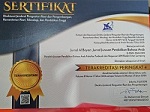Popular Phonetic Mapping in The Qur’an and Its Implications on Teaching Arabic for Non-Native Speakers
Abstract
Keywords
Full Text:
PDFReferences
Al-Shishtawi, Hamid Ibrahim. “The Behavior of Noon Saakinah and Tanween in Qur’anic Recitation: In the Light of Generative Phonology.” International Journal of Language & Linguistics 5, no. 4 (2018): 81–89. https://doi.org/10.30845/ijll.v5n4p9.
Abdullah, I., Abu Bakr, P.,& Bagduan, A. (2011). Teaching and learning of Arabic language between the challenges and ambition. International Conference to teach Arabic (pp. 74-96). Beijing, China: Faculty of Arabic Language, Arabic Studies University, 5-6 December.
Agerström, J., & Rooth, D.-O. (2009). Implicit prejudice and ethnic minorities: ArabMuslims in Sweden. International Journal of Manpower, 30(1/2), 43–55
Al-Busaidi, F., Al Hashmi, A., Al Musawi. A & Kazem, A .(1016). Teachers' perceptions of the effectiveness of using Arabic language teaching software in Omani basic education. International Journal of Education and Development
Al‐Rajhi, I., Bartlett, D., & Altman, Y. (2013). Research note: the development of an Arabic cross‐cultural adjustment scale. Cross Cultural Management: An International Journal, 20(3), 449–463.
Ali al-’Ūfī, I. bin M. “Al-Af’āl Al-Nāsikhah Al-Shā’i’ah Fi Surah Al-Baqarah Wa Fā’idatu Ta’līmiha Lighayri Al-Nātiqīna Bihā.” Al-Majallah Al-’Alamiyyah Li Kullliyah Al-Tarbiyyah 33, no. 3 (2017): 110–38.
Altıparmak Yılmaz, H. Merve, and Necati Demir. “Error Analysis: Approaches to Written Texts of Turks Living in the Sydney.” International Education Studies 13, no. 2 (2020): 104. https://doi.org/10.5539/ies.v13n2p104.
Amini, Reza, and Javad Bayesteh. “Investigating Error Analysis in Interlinguistic English Language Teaching and the Consequences of Contradictory Analysis on Teaching Quality” 4, no. 1 (2020): 41–44. https://doi.org/10.22034/JHI.2020.109840.
Asiyaban, Amir Reza, Mortaza Yamini, Mohammad Sadegh Bagheri, and Lotfollah Yarmohammadi. “A Cross-Sectional Investigation into the Implicit and Explicit Knowledge of the Article System in Iranian Learners’ Approximative System.” International Journal of Instruction 12, no. 4 (2019): 479–94. https://doi.org/10.29333/iji.2019.12431a.
Bani Salameh, Mohammad Yahya. “The Phonetic Nature of Consonants in Modern Standard Arabic.” English Linguistics Research 4, no. 3 (2015): 30–57. https://doi.org/10.5430/elr.v4n3p30.
Basyar, Kamal Muhammad. ‘Ilm Al-Lugat Al-’Ām Al-Aṣwāt. 7th ed. Cairo, Egypt: Dar al- Ma’arif, 1969.
Brierley, Clare, Majdi Sawalha, Barry Heselwood, and Eric Atwell. "A verified Arabic-IPA mapping for Arabic transcription technology, informed by Quranic recitation, traditional Arabic Linguistics, and modern phonetics." Journal of Semitic Studies 61, no. 1 (2016): 157-186.
Buniyatova, Isabella. “The Linguistic Philosophy of Noam Chomsky.” Studia Philologica 14, no. 1 (2020): 7–10. https://doi.org/https://doi.org/10.28925/2311-2425.2020.141.
Catford, J.C. A Practical Introduction to Phonetics. 2nd ed. New York: Oxford University Press, 2001.
Clayards, Meghan, M. Gareth Gaskell, and Sarah Hawkins. "Phonetic Detail is used to Predict a word’s Morphological Composition." Journal of Phonetics 87 (2021): 101055.
Danesi, Marcel. “Charles Fries and Contrastive Analysis.” In Toward an Understanding of Language: Charles Carpenter Fries in Perspective, edited by Peter H. Fries and Nancy M. Fries, Amsterdam/Philadelphia: John Benjamins, 1985.
DeKeyser, Robert. “Repetition for Language Learning: A Perspective from Skills Acquisition Theory.” In Learning Language Through Task Repitition, edited by Martin Baygate, Amsterdam/Philadelphia: John Benjamins Publishing Company, 2018.
Elyas, T., & Picard, M. (2010). Saudi Arabian Educational History: Impacts on English language teaching. Education, Business and Society: Contemporary Middle Eastern Issues, 3, 136–145.
Fawzan, A. (2011). Idaat lmoalme alugah alarabiah [Illuminations of teachers of Arabic language] (1st ed.). Riyadh: Arabic for all.
Hakim, Arief Rahman. “Alif Layyinah dalam Perspektif Morfologis”, Repository of Maulana Malik Ibrahim State Islamic University of Malang (2020).
Hardan, Nur Hikmatul Auliya, Helmina Andriani, Roushandy Asri Fardani, Jumari Ustiawaty, Evi Fatmi Utami, Dhika Juliana Sukmana, and Ria Rahmatul Istiqomah. Buku Metode Penelitian Kualitatif Dan Kuantitatif. I. Yogyakarta: CV Pustaka Ilmu, 2020.
Hasan, Naifah. “‘Ilm Al-’Aṣwāt Al-‘Arabiyyah: Taṭawwurātuhā Wa Naẓariyyatuhā Wa Al-’Istifādat Minhā Li Ta’līm Al-Lugat Al-‘Arabiyyati.” Al-Ta’rib : Jurnal Ilmiah Program Studi Pendidikan Bahasa Arab IAIN Palangka Raya 6, no. 2 (2018): 144–55. https://doi.org/10.23971/altarib.v6i2.1070.
Hasan, Tamam. Al-Lugat Al-‘Arabiyyah: Ma‘nāhā Wa Mabnāhā. Dar al-Tsaqafah, 1994.
Hifny, Yasser. “Open Vocabulary Arabic Diacritics Restoration.” IEEE Signal Processing Letters 26, no. 10 (2019): 1421–25. https://doi.org/10.1109/lsp.2019.2933721.
Homstad, T., & Thorson, H. (1996). Using Writing-to-Learn Activities in the Foreign Language Classroom. Technical Report No. 14. Minneapolis, MN: University of Minnesota, Center for Interdisciplinary Studies of Writing.
Hung, D. (2001). Theories of Learning and Computer-Mediated Instructional Technologies. Education Media International, 38(4), 281-287.
Huthaily, K. (2008). Second Language Instruction with Phonological Knowledge: Teaching Arabic to Speakers of English. (Doctoral Dissertations) Retrieved from http://scholarworks.umt.edu/cgi/viewcontent.cgi?article=1890& context=etd
Isnainiyah, Isnaniyah. “Penggunaan Nama-Nama Orang Madura Ditinjau Dari Bentuk Aslinya Dalam Bahasa Arab.” In Seminar Nasional Bahasa Arab Mahasiswa II (2018): 429–442.
Java, Nadir. “Al-Alif Al-Layyinah wa al-Yābisah,” accessed November 27, 2021, https://javanet.sudanforums.net/t39-topic.
Johnson, Heather. “The Natural Order Hypothesis: Definition and Criticism,” accessed November 27, 2021, https://parentingpatch.com/natural-order-hypothesis-definition-criticism/.
Junaidi, Junaidi, and Baiq Mulianah. “Pengaruh Kefasihan Membaca Al-Qur’an Terhadap Keterampilan Membaca Pada Bidang Studi Bahasa Arab.” El-Tsaqafah : Jurnal Jurusan PBA 19, no. 2 (2021): 199–215. https://doi.org/10.20414/tsaqafah.v19i2.2949.
Keen, R.G. “Human Voices and the Wah Pedal.” Accessed November 27, 2020. http://www.geofex.com/Article_Folders/wahpedl/voicewah.htm.
Lai, Wen, and Lifang Wei. “A Critical Evaluation of Krashen’s Monitor Model.” Theory and Practice in Language Studies 9, no. 11 (2019): 1459–64. https://doi.org/http://dx.doi.org/10.17507/tpls.0911.13.
Latif, Emad Abdul. “Arabic Political Discourse.” The Routledge Handbook of Arabic Linguistics (2017): 1–580, https://doi.org/10.4324/9781315147062.
Liu, Dayan. “A Critical Review of Krashen’s Input Hypothesis: Three Major Arguments.” Journal of Education and Human Development 4, no. 4 (2015): 139–46. https://doi.org/10.15640/jehd.v4n4a16.
Maddieson, I., and K. Emmorey. “Relationship between Semivowels and Vowels: Cross-Linguistic Investigations of Acoustic Difference and Coarticulation.” Phonetica 42, no. 4 (1985): 163–74. https://doi.org/10.1159/000261748.
Madkour, A. (2003). Aktrbiyah wathgafatal technologyia [Education and culture of technology] (1st ed.). Cairo: Dar AlfikrAlarabi.
Mahmoud, A., Sahrir, M & Osman, R. (2013). Integration of an Interactive Program in Learning Arabic Language for Non-Native Speakers via Virtual Tutor. GEMA Online Journal of Language Studies, 13(3), 117-131
Miles, Matthew B, A Michael Huberman, and Johnny Saldana. Qualitative Data Analysis: A Methods Sourcebook. 3rd ed. USA: Sage Publications, 2014.
Mohamed, Yuslina, Mesbahul Hoque, Tuan Haji Sulaiman Bin Ismail, Mohamed Hj Ibrahim, Nurhasma Muhamad Saad, and Nurul Nazariah Mohd Zaidi. "Relationship Between Phonology, Phonetics, and Tajweed: A Literature Review." In 4th International Conference on Sustainable Innovation 2020–Social, Humanity, and Education ICoSIHESS 2020 (2021): 407-411.
Nasution, Ahmad Sayuti Anshari. Fonetik & Fonologi Alquran. Jakarta: Amzah, 2018.
Nurjan, Syarifan. Psikologi Belajar Edisi Revisi. Ponorogo: Wade Group, 2016. http://eprints.umpo.ac.id/4909/1/Buku Psikologi Belajar.pdf.
Purwita, Naila Iffah, Moch Arif Bijaksana, Kemas Muslim Lhaksmana, and Muhammad Zidny Naf’an. “Typo Handling in Searching of Quran Verse Based on Phonetic Similarities.” Register: Jurnal Ilmiah Teknologi Sistem Informasi 6, no. 2 (2020): 130–40. https://doi.org/10.26594/register.v6i2.2065.
Rizal, M. Khoirul. “Tradisi Pembacaan Surat Al-Waqi’ah Di Kalangan Santri (Studi Living Qur’an di Pondok Pesantren Al Falah Ploso Mojo Kediri).” IAIN Salatiga (2021).
Seddiqi-nejad, Sepehr, and Seyed Farid Khalifehlou. “Introducing Some Idiosyncratic Phonological Features of Rūdbāri (Kerman) Dialect.” Journal of Prose Studies in Persian Literature 20, no. 42 (2017): 183–204. https://doi.org/10.22103/JLL.2017.1717.
Selinker, Larry. “Interlanguage” X, no. 3 (1972): 209–32.
Shariq, Mohammed. “Arabic and English Consonants: A Phonetic and Phonological Investigation.” Advances in Language and Literary Studies 6, no. 6 (2015): 146–52. https://doi.org/10.7575/aiac.alls.v.6n.6p.146.
Shooshtari, Mohammad Ebrahim Khalifeh, and Taleb Rabiei. “A Phonetics Study of Surah Yunus.” Reasarch in Arabic Language 20, no. 20 (2019): 1–20. https://doi.org/10.22108/rall.2018.111384.1142.
Al-Syafii, Sulaiman bin Umar Al-Ajili. Al-Futuhat Al-Ilahiyyah Li Tawdhih Tafsir Al-Jalalain Li Al-Daqaiq Al-Khafiyyah. Beirut: Dar al-kutub al-Ilmiyyah, 2011.
Tajabadi, Farzaneh, and Aliyeh Kord-e Zafaranlu Kambuziya. “Determination of Quranic Verse-Final Pauses’(Fawāṣil) Phonetic Model Based on Phonological Distinctive Features.” Islamic Studies and Culture 2, no. 1 (2018): 1–18.
Tarkpegher, Henry Terngu, and Nwokeke Godspower Ikechukwu. “A Contrastive Analysis Of The Morphological Structure Of Nigerian Pidgin English And Nigerian English.” Journal of Languages, Linguistics and Literary Studies (JOLLS) 10, no. 2 (2021): 1–9.
Ziafat, Nishmia, Hafiz Farooq Ahmad, Iram Fatima, Muhammad Zia, Abdulaziz Alhumam, and Kashif Rajpoot. “Correct Pronunciation Detection of the Arabic Alphabet Using Deep Learning.” Applied Sciences (Switzerland) 11, no. 6 (2021): 1–19. https://doi.org/10.3390/app11062508.
DOI: http://dx.doi.org/10.24042/albayan.v14i1.9757
Refbacks
- There are currently no refbacks.
Copyright (c) 2022 Jurnal Al Bayan: Jurnal Jurusan Pendidikan Bahasa Arab
License URL: https://creativecommons.org/licenses/by-sa/4.0
Editorial Office:
Jurnal Al Bayan: Jurnal Jurusan Pendidikan Bahasa Arab, Arabic Education Study Program, Faculty of Education and Teachers Training, Unversitas Islam Negeri Raden Intan Lampung
Jl. Endro Suratmin 1 Sukarame, Bandar Lampung 35131-Indonesia
e-mail: jurnalalbayan@radenintan.ac.id
http://ejournal.radenintan.ac.id/index.php/albayan/index
Jurnal Al Bayan: Jurnal Jurusan Pendidikan Bahasa Arab is licensed under a Creative Commons Attribution-ShareAlike 4.0 International License. p-ISSN 2086-9282 | e-ISSN 2549-1229









